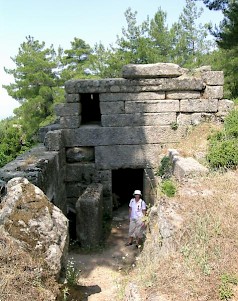Idrieus
Idrieus: satrap of Caria between 351 and 344, member of the Hecatomnid dynasty.

Idrieus (or Hidrieus as he is sometimes called), was the second son of Hecatomnus, who had been made satrap of Caria in 391, and had been succeeded by Maussolus, Idrieus' elder brother. After the death of Maussolus, his wife and sister Artemisia had occupied the office from 353 tot 351, and after her death, her brother Idrieus became satrap. He was to be the ruler of Caria for seven years.
At about the time of Idrieus' accession, the Achaemenid king Artaxerxes III Ochus had sent an army to attack Egypt, but it had been defeated by the Greek mercenaries of the pharaoh, Nectanebo II. Immediately, the Persian king ordered a new army to be assembled at Sidon, but the population of this Phoenician city was unable to cope with the great numbers of foreigners and revolted. Nectanebo sent mercenaries, commanded by Mentor of Rhodes, to help the Sidonians against their Persian overlord, and the revolt immediately spread to Cyprus.
Artaxerxes now ordered the satrap of Caria to raise an army and fleet to reconquer Cyprus. The satraps of Cilicia and Syria, Mazaeus and Belesys, had to proceed to the rebellious country and contain the revolt. However, they were repelled by Mentor, and it is possible that the revolt spread to Samaria and Judaea in the south. Now, the king personally proceeded to Sidon, which he captured in 345. In the meantime, Idrieus had obeyed and had brought the Athenian commander Phocion, who led an army of mercenaries, and the Cypriote leader Euagoras II to the island.
However, it is possible that he was not altogether loyal. In 346, the Athenian orator Isocrates addressed a speech to king Philip of Macedonia, in which he argued that it would be easy to overthrow the Persian empire, because Egypt, Phoenicia, and Cyprus were still in revolt and Idrieus of Caria -who is also presented as the most wealthy ruler in Asia Minor- might be a useful ally. Perhaps Isocrates knew something that modern historians do not know. In any case, One year after the speech had been delivered, Sidon had been captured, and in 344, the Cypriote rebellion was over as well.
At that moment, Idrieus was no longer alive: in 344, he died of a disease. In his will, he made his sister and wife Ada his successor. This was a crucial mistake. Their younger brother Pixodarus did not like the idea, and quarreled with his sister. The power of Caria, which had been created by Maussolus and expanded by Idrieus, was soon in decline. Ten years after the death of Idrieus, a Persian named Orontobates was satrap of Caria.
He had been appointed by king Darius III Codomannus and had tried to obtain popular support by marrying a daughter of Pixodarus. Ada, however, was still popular, and when, in 334, the Macedonian king Alexander the Great approached Caria, she was reappointed as satrap by the future "king of Asia".
Building activity of Idrieus is attested in Halicarnassus, where he must have finished the Mausoleum, and at Labranda, where he restored the temple of Zeus, added the southern and eastern entrances, and built the 'Doric house'.